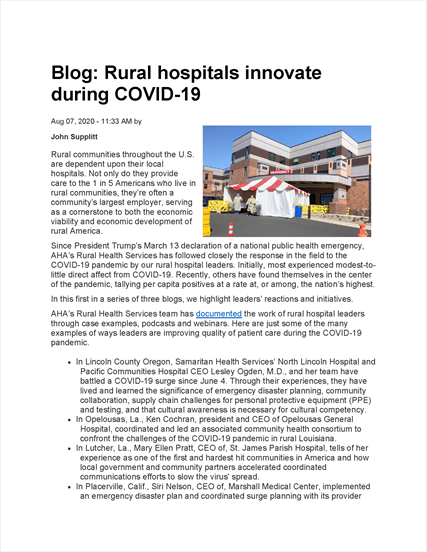Blog: Rural hospitals innovate during COVID-19
Rural communities throughout the U.S. are dependent upon their local hospitals. Not only do they provide care to the 1 in 5 Americans who live in rural communities, they’re often a community’s largest employer, serving as a cornerstone to both the economic viability and economic development of rural America.
Since President Trump’s March 13 declaration of a national public health emergency, AHA’s Rural Health Services has followed closely the response in the field to the COVID-19 pandemic by our rural hospital leaders. Initially, most experienced modest-to-little direct affect from COVID-19. Recently, others have found themselves in the center of the pandemic, tallying per capita positives at a rate at, or among, the nation’s highest.
In this first in a series of three blogs, we highlight leaders’ reactions and initiatives.
AHA’s Rural Health Services team has documented the work of rural hospital leaders through case examples, podcasts and webinars. Here are just some of the many examples of ways leaders are improving quality of patient care during the COVID-19 pandemic.
- In Lincoln County Oregon, Samaritan Health Services’ North Lincoln Hospital and Pacific Communities Hospital CEO Lesley Ogden, M.D., and her team have battled a COVID-19 surge since June 4. Through their experiences, they have lived and learned the significance of emergency disaster planning, community collaboration, supply chain challenges for personal protective equipment (PPE) and testing, and that cultural awareness is necessary for cultural competency.
- In Opelousas, La., Ken Cochran, president and CEO of Opelousas General Hospital, coordinated and led an associated community health consortium to confront the challenges of the COVID-19 pandemic in rural Louisiana.
- In Lutcher, La., Mary Ellen Pratt, CEO of, St. James Parish Hospital, tells of her experience as one of the first and hardest hit communities in America and how local government and community partners accelerated coordinated communications efforts to slow the virus' spread.
- In Placerville, Calif., Siri Nelson, CEO of, Marshall Medical Center, implemented an emergency disaster plan and coordinated surge planning with its provider partners, local county resources and state resources, which includes potential expansion beyond the hospital physical walls.
- In Neodesha, Kan., Dennis Shelby, CEO of Wilson Medical Center, and his team identified consumer-conscious approaches to testing and caring for patients, and created a community collaboration to acquire personal protective equipment that will prove useful in a post-COVID-19 environment.
- In Batesville, Ind., Tim Putnam, CEO of Margaret Mary Health, and his team remain in the center of the pandemic, of which he described the efforts of this small rural community to bend the curve while addressing hospital employees’ physical and emotional needs.
- In Brookhaven, Miss., Alvin Hoover, CEO of King's Daughters Medical Center, and his team were confronted with an early surge of COVID-19 patients and among those on the front lines who exemplified the resourcefulness of the community in acquiring scarce resources, such as PPE, while fabricating ventilators to meet an unprecedented demand.
- In Dixon, Ill., CEO Dave Schreiner and his team at Katherine Shaw Bethea Hospital worked to get ahead of the curve by engineering drive-through COVID-19 testing and an immediate response team.
- In Aitkin, Minn., Todd Sandberg, CEO of, Riverwood Healthcare Center, and his team launched rapid deployment of telehealth services to increase access points in advance of COVID-19,
- In Garberville, Calif., Matt Rees, administrator at Southern Humboldt Community Healthcare District and Jerold Phelps Community Hospital, mobilized staff and volunteers to address the social determinants of health for the 3,400 seniors living in this vast frontier area.
As you can see, hospitals serving rural America have braved the gauntlet of challenges thrown their way by this pandemic. You have demonstrated resilience, resourcefulness and ingenuity in managing under the most extreme and unprecedented conditions.
You have earned the nation’s respect and admiration.
While Congress and the administration’s interventions have been effective and much appreciated, they nonetheless are temporary. Much more can and must be done to assure continued access to care for vulnerable rural communities. AHA Rural Health Services and the entire AHA will continue to share the efforts of rural hospital leaders while advocating for the best interests of rural health care providers and the communities they serve.
John Supplitt is senior director of AHA Rural Health Services.


